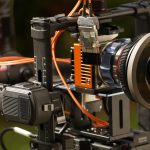Most film MTF curves can be closely approximated by a function known as the Lorentzian,
MTF(f) = 1/(1+( f/f50)2)
, where:
f is spatial frequency;
f50 is the spatial frequency where MTF = 0.5 = 50%.
For Kodak E100VS reversal film green layer, f50 = 40 line pairs/mm. MTF( f ) is expressed in functional notation, which indicates that MTF is a function of spatial frequency, f.
Accordingly, f20 = 80 line pairs/mm, or 160 lines/mm.
In case of Kodak E100VS, the MTF 50 is approximately 40 line pairs/mm or 80 lines/mm. As IMAX 70mm film is 52mm high, this translates to
MTFIMAX 50 = 4,160 LW/PH (or 5,600 LW/PW)
and
MTFIMAX 20 = 8,320 LW/PH (or 11,200 LW/PW)
PH stands for Picture Height, PW stands for Picture Width.



